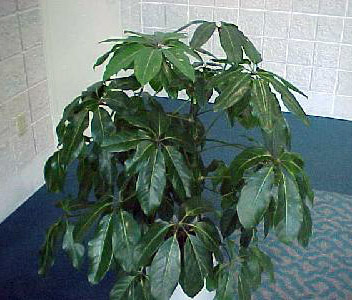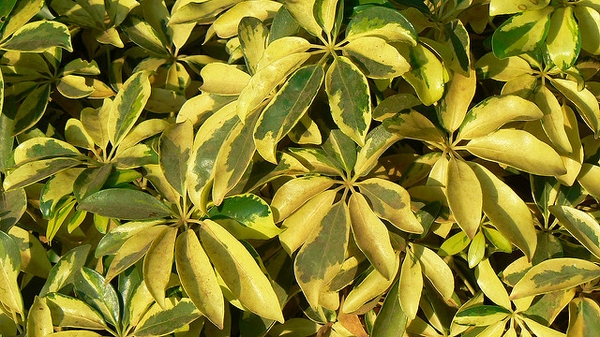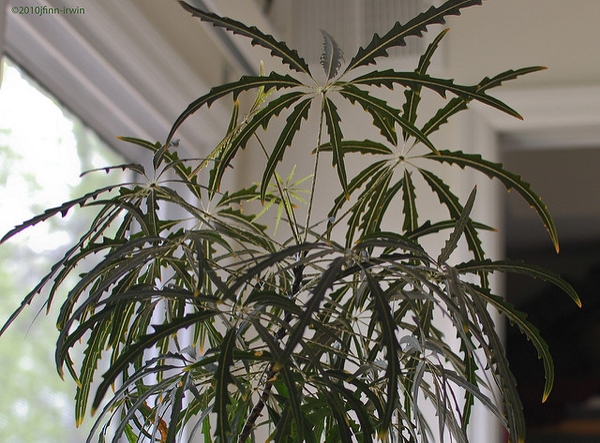Another Engaging Houseplant: Schefflera
by Nancy Miller, Fairfax Master Gardener
 Just the name ‘schefflera’ has always made me smile. It’s so easy to get your tongue twisted when pronouncing it. Then I found out that one of the world’s most popular houseplants has been misnamed. Due to research on the 650 species making up the huge genus Schefflera, and then DNA testing, we now know only seven species legitimately belong in the genus Schefflera. They are all native to the western Pacific Ocean, and none have been marketed as cultivated plants in the U.S.
Just the name ‘schefflera’ has always made me smile. It’s so easy to get your tongue twisted when pronouncing it. Then I found out that one of the world’s most popular houseplants has been misnamed. Due to research on the 650 species making up the huge genus Schefflera, and then DNA testing, we now know only seven species legitimately belong in the genus Schefflera. They are all native to the western Pacific Ocean, and none have been marketed as cultivated plants in the U.S.
What should we correctly call this popular houseplant? It is now known scientifically as Heptapleurum. However, in searching commercial and academic sites on-line, all commercial sites and most academic sites are still referring to these plants as Schefflera.
They are tall and graceful tropical plants that would be great additions to your houseplant array. The varieties offered for sale to us are native to Central and South America, not the western Pacific. Long-lived as houseplants, they can only be grown outside safely in Zone 10. As houseplants, they are undemanding and under the right conditions can be summered outdoors in our area.
All three varieties of Schefflera have evergreen, glossy compound leaves, palmate and arranged in a circle on the leafstalk. Each leaf has from three to twelve oblong leaflets, depending on variety and age. Rarely flowering indoors, outside they produce tiny flowers in compound panicles and drupes that darken to black when mature.
Schefflera prefer daytime temperatures between 65 to 75 degrees (18 to 23º C) with nights about 60 degrees (15º C). Cold drafts can cause dead areas on leaves several days after exposure, so stay aware of vent locations.
Water only when the top inch of soil is dry, and never let the plant sit in water. Schefflera like high humidity and a well-drained potting medium rich in organic matter. If you need to raise humidity, fill a tray with pebbles and water but don’t let the water reach the bottom of the pot. Overly frequent or excessive watering will result in root rot. Leaf drop might occur if the soil is too wet or too dry.

Heptapleurum arboricola
Fertilize regularly with water-soluble or timed-release houseplant fertilizer, following the label directions. Overcrowded plants can be repotted in any season, using general purpose potting soil. If pruning is necessary, cut just above a leaf. Propagation is by seed, cuttings or air-layering.
Possible pests include red spider mites, mealybugs and scale. Standard Pest Management Guide procedures will control these, as will good air flow around the plant. As always, carefully inspect any plant before purchasing it.
PLEASE NOTE: All parts of Schefflera are seriously toxic to dogs and cats.
Heptapleurum arboricola is also known as dwarf schefflera. It can grow 10 feet to 15 feet (3 to 4.5 m) tall outside in south Florida but stays at 4 feet to 6 feet (1.2 to 1.8 m) high and wide in a container indoors. It has seven to eleven short, glossy leaflets up to 4 inches (10 cm) long when mature. Its leaves are thicker than those of H. actinophylla. There are also cultivars with golden or variegated foliage.

Plerandra elegantissima
In a home setting H. arboricola requires three to four hours of filtered sunlight daily. For a southern or western window, you can use a sheer curtain to filter the light. The plant can safely be put outside in a sheltered area when the temperature is above 60 degrees (15º C).
H. actinophylla (also known as octopus tree or parasol plant) is the most commonly grown of this species. It can get 8 feet to 10 feet (2.5 to 3m) tall indoors. Its umbrella-like leaves have seven to twelve large leathery glossy leaflets up to 12 inches (30 cm) long.
False aralia is scientifically known as Plerandra elegantissima. This variety is also in the Araliaceae family but is a native of New Caledonia. When young, its leaflets have a coppery-green underside and are one-half inch wide and 3 inches (8 cm) long but mature to 3 inches (8 cm) wide and 12 inches long (30 cm) and lose some of their glossiness. It is an upright, multi-trunked tree growing about 5 feet high (1.5 m) and 3 feet wide (1 m) in a container.
Enjoy experimenting with a new-to-you variety of Schefflera.
-
References
- Heptapleurum arboricola, North Carolina State University Extension
- Schefflera, Clemson Cooperative Extension
- Popular plant is sold under wrong name, VCU News, Virginia Commonwealth University
- Plerandra elegantissima,(Dizygotheca elegantissima), University of Florida Extension